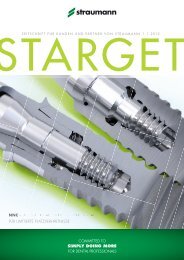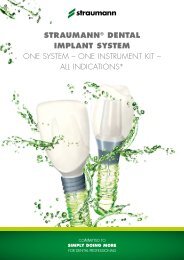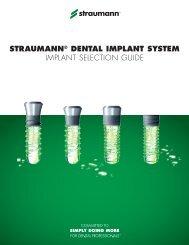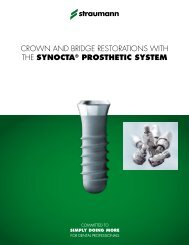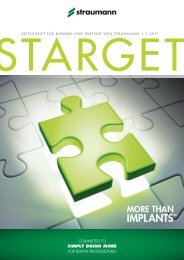Basic information on the surgical procedures - Straumann
Basic information on the surgical procedures - Straumann
Basic information on the surgical procedures - Straumann
Create successful ePaper yourself
Turn your PDF publications into a flip-book with our unique Google optimized e-Paper software.
Tapping<br />
Tapping prepares <strong>the</strong> implant bed for a specific thread type. It is an opti<strong>on</strong>al step that gives <strong>the</strong> surge<strong>on</strong> <strong>the</strong> flexibility<br />
to adjust <strong>the</strong> <strong>surgical</strong> protocol to <strong>the</strong> b<strong>on</strong>e class to help achieve optimal primary stability. It is recommended in dense b<strong>on</strong>e<br />
and with large diameter implants in order to keep <strong>the</strong> inserti<strong>on</strong> torque in a desirable range. The table below summarizes suggested<br />
tap usage.<br />
Note<br />
TE implants generally do not need tapping.<br />
In specific situati<strong>on</strong>s of TE implants (e.g. dense b<strong>on</strong>e c<strong>on</strong>diti<strong>on</strong>s), <strong>the</strong> BL/TE tap can be used according to <strong>the</strong> recommendati<strong>on</strong><br />
for BL implants as suggested in <strong>the</strong> table below.<br />
Tapping according to b<strong>on</strong>e class<br />
S, SP implants BL implants<br />
B<strong>on</strong>e Endosteal diameter Endosteal diameter<br />
Classes* Ø 3.3 mm Ø 4.1 mm Ø 4.8 mm Ø 3.3 mm Ø 4.1 mm Ø 4.8 mm<br />
Class 1 full full full full full full<br />
Class 2 cor<strong>on</strong>al cor<strong>on</strong>al full full full full<br />
Class 3 full full<br />
Class 4 full full<br />
* Class 1: hardest<br />
b<strong>on</strong>e/Class 4: soft<br />
b<strong>on</strong>e<br />
cor<strong>on</strong>al = thread tapping<br />
in <strong>the</strong> cor<strong>on</strong>al<br />
area of <strong>the</strong> implant<br />
bed<br />
full = thread tapping<br />
over full depth of <strong>the</strong><br />
implant bed<br />
<strong>Straumann</strong> ® Standard and Standard Plus taps<br />
<strong>Straumann</strong> ® B<strong>on</strong>e Level and<br />
Tapered Effect taps<br />
Tap for adapter Tap for adapter<br />
Coupling for<br />
adapter<br />
Depth mark<br />
Coupling for adapter<br />
Label for implant type<br />
Depth mark<br />
Cutting head<br />
S/SP taps are used in <strong>the</strong> cor<strong>on</strong>al area <strong>on</strong>ly or over <strong>the</strong> full<br />
depth of <strong>the</strong> implant bed, depending <strong>on</strong> implant diameter and<br />
b<strong>on</strong>e class (see table above).<br />
Cutting head<br />
If a BL/TE tap is used, it should always<br />
be inserted over <strong>the</strong> full depth of <strong>the</strong> implant<br />
bed preparati<strong>on</strong> (see table above).<br />
BL/TE taps are available for adapter<br />
<strong>on</strong>ly.<br />
Cauti<strong>on</strong><br />
<strong>Straumann</strong> ® taps<br />
are to be used<br />
<strong>on</strong>ly for <strong>the</strong> corresp<strong>on</strong>ding<br />
implant<br />
type!<br />
15 rpm max. 15 rpm max.<br />
38<br />
4. Surgical <strong>procedures</strong> 4.1 Implant bed preparati<strong>on</strong>






